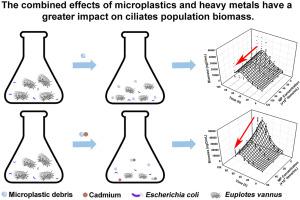Environmental Pollution ( IF 8.9 ) Pub Date : 2022-06-20 , DOI: 10.1016/j.envpol.2022.119663 Ya-Xin Wang 1 , Ming-Jian Liu 2 , Xian-Hui Geng 1 , Yan Zhang 1 , Rui-Qi Jia 1 , Yi-Ning Zhang 1 , Xiao-Xiao Wang 1 , Yong Jiang 2

|
Microplastics could be grazed by marine organisms and possibly transferred to higher trophic levels along the microbial loop. Due to their size and capacity to concentrate heavy metals that trigger joint toxic effects, microplastics (MPs) have already become a severe threat to marine organisms. The detrimental effects of MPs on large marine organisms have been studied, but the combined toxicity of MPs and cadmium (Cd) on protozoan ciliates remains unclear. In the present study, we selected different diameters and concentrations of polystyrene microspheres (PS-MPs) and Cd2+ as model MPs and heavy metals to evaluate their single and combined effects on the periphytic marine ciliate Euplotes vannus in relation to carbon biomass and oxidative stress. The MPs were indeed ingested by Euplotes vannus and significantly reduced the abundance and carbon biomass of ciliate populations. Combined exposure to MPs and Cd2+ not only increased the bioaccumulation of Cd2+ in ciliates but also exacerbated the decrease in ciliate biomass by increasing oxidative stress and membrane damage. In comparison, the effects of nano-sized plastics (0.22 μm) were more harmful than those of micro-sized plastics (1.07 μm, 2.14 μm and 5.00 μm). A smaller size represents a higher potential for penetrating biological members and a stronger adsorption capacity for cadmium. These results provide new insight into the combined toxicity of microplastics and heavy metals on ciliated protozoa and lay a foundation for higher trophic levels and ecosystems.
中文翻译:

微塑料和重金属镉对海洋附生纤毛虫 Euplotes vannus 的综合影响
微塑料可以被海洋生物放牧,并可能沿着微生物循环转移到更高的营养水平。由于它们的大小和浓缩重金属的能力,会引发关节毒性作用,微塑料 (MPs) 已经成为对海洋生物的严重威胁。已经研究了 MPs 对大型海洋生物的有害影响,但 MPs 和镉 (Cd) 对原生动物纤毛虫的联合毒性仍不清楚。在本研究中,我们选择不同直径和浓度的聚苯乙烯微球 (PS-MPs) 和 Cd 2+作为模型 MPs 和重金属,以评估它们对附生海洋纤毛虫Euplotes vannus与碳生物量和氧化作用的单一和综合影响。压力。国会议员确实被Euplotes vannus显着降低了纤毛虫种群的丰度和碳生物量。MPs和Cd 2+的联合暴露不仅增加了Cd 2+在纤毛虫中的生物积累,而且通过增加氧化应激和膜损伤加剧了纤毛虫生物量的减少。相比之下,纳米塑料(0.22 μm)的影响比微米塑料(1.07 μm、2.14 μm和5.00 μm)的危害更大。较小的尺寸代表了更高的穿透生物成员的潜力和更强的镉吸附能力。这些结果为了解微塑料和重金属对纤毛原生动物的综合毒性提供了新的见解,并为更高的营养水平和生态系统奠定了基础。



























 京公网安备 11010802027423号
京公网安备 11010802027423号